![]()
![]()
![]()
Use LEFT and RIGHT arrow keys to navigate between flashcards;
Use UP and DOWN arrow keys to flip the card;
H to show hint;
A reads text to speech;
35 Cards in this Set
- Front
- Back
- 3rd side (hint)
|
Cell Cycle |
The process of eukaryotic cell division |
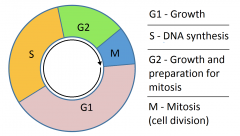
2. Although all cells have the ability to preform the cell cycle, some do not. |
|
|
Mitosis |
The stage of the cell cycle where a cell's nuclear material is distributed. |
1. The process where the metaphase plate and spindle poles form 2. Cells do not actually physically divide when they perform Mitosis |
|
|
G1/G0 |
The first stage of the cell cycle where cells synthesize macromolecules, and may choose to remain instead of advancing |
1. The stage before the restriction point 2. Brain cells almost always remain in the G1/G0 phase |
|
|
S |
The second stage of the cell cycle where the DNA of chromosomes copy identically |
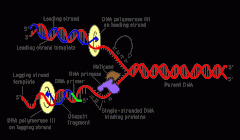
2. The S stage involves more than 20 enzymes |
|
|
G2 |
The stage of the cell cycle where RNA and proteins are made that help with Mitosis |
1. The stage that only synthesizes proteins and nucleotides 2. Unlike the G1 stage the G2 stage does not have a Restriction Point |
|
|
Restriction Point |
The point in the cell cycle where the cell is unable to revert to the G1/G0 phase |
1. The point in the late stages of G1 2. The restriction point is sometimes called "the point of no return" |
|
|
M |
The last phase of the cell cycle where the cell both divides its genetic material and divides physically |
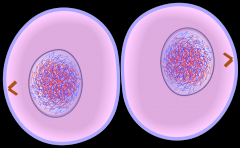
2. The M phase encompasses both mitosis and cytokinesis |
|
|
Cytokinesis |
The physical division of the cell during the M phase |

2. Cytokinesis can happen in places of the M phase |
|
|
Daughter Cell |
The cell created as a result of the M phase in the cell cycle |
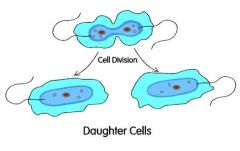
2. Each daughter cell has the exact same DNA as its parent cell |
|
|
Nucleotide base pairing |
The specific affinities of the nucleotide bases T & A and G & C when it comes to hydrogen bonding |
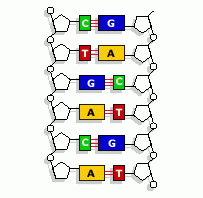
2. The nucleotide base pairings of T and A result because of their two hydrogen bonds |
|
|
Hydrogen Bond |
A weak attraction between a slightly positive hydrogen atom and a slightly negative atom in a different (or the same) molecule |
1. A slightly positive hydrogen and a slightly weak nitrogen in a amino acid 2. The two molecules were held together by a hydrogen bond with nitrogen. |
|
|
Antiparallel |
Similar strands of DNA that run in opposite directions |
1. A Divided Highway 2. It is because of the antiparallel sugar phosphate backbones that DNA polymerase can only prime one strand |
|
|
DNA Polymerase |
The enzyme that makes new DNA strands adding nucleotides to RNA |
1. The enzyme that checks its nucleotide pairings immediately after it pairs them 2. DNA Polymerase unwinds as it works |
|
|
Semiconservative Replication |
DNA replication where each strand is half made of previous nucleotides and half made of recently synthesized nucleotides |

2. Semiconservative Replication means we have genetic material from the first humans in us |
|
|
Histone |
Basic nucleosome proteins that bind to DNA and counter its charge |

2. Histones are why we can choose when to activate genes |
|
|
Chromosome |
Tightly coiled strand of DNA |
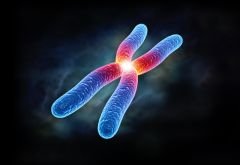
2. Eukaryotes have multiple chromosomes |
|
|
Chromatin |
The DNA form when it is bound to nucleosomes |
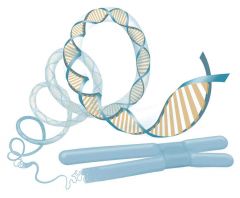
2. Eukaryotic DNA is mostly in chromatin form |
|
|
Mutation |
Error in the sequence of a cell's DNA, that can be silent, helpful, or harmful |
1. If an A base is paired with a C base 2. Although mutations can kill us they are responsible for evolution |
|
|
Mutagen |
Environmental factors that can cause DNA mutations |
1. Ultraviolet Light 2. Cells use excision repair to fix damage from mutagens |
|
|
Excision Repair |
Biological process in which DNA damage from mutagens is fixed |
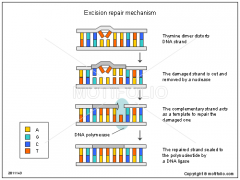
2. Excision repairs severely limits the number of mutations in human cells |
|
|
Sister Chromatids |
Identical copies of chromosomes synthesized in the cell cycle |

2. Sister Chromatids contain identical genetic material |
|
|
Centromere |
Small point that connecting sister chromatids |
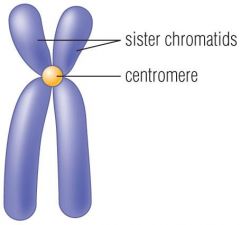
2. The centromere is removed in the anaphase stage |
|
|
Aneuploid |
Cells with too many or too few chromosomes as a result of a dividing mistake |
1. A cell with an extra copy of a chromosome 2. If an aneuploid cell is missing too much genetic material it may not be able to function |
|
|
Prophase |
The first step of mitosis where a microtubule bond is formed between centrioles and the chromatids |
1. The stage where the spindle poles form 2. Microtubules act like a lasso around kinetochores during prophase |
|
|
Metaphase |
The second step of mitosis where genetic material is divided |
1. The stage where kinetochore proteins begin to pull the chromatids 2. The trademark of metaphase is the metaphase plate |
|
|
Anaphase |
The third step of mitosis where the sister chromatids seperate |
1. The stage where chromatids can be referred to as chromosomes 2. In eukaryotic cells cytokinesis occurs during anaphase |
|
|
Telophase |
The final step of mitosis where the two chromosome bundles become two seperate cells |
1. The stage where the nuclear envelope reforms 2. Plants have an extra step during the telophase |
|
|
(Mitiotic) Spindle (Fibers) |
The formation of microtubules during the prophase |
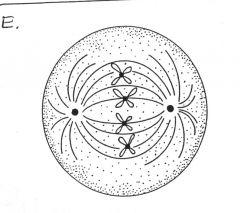
2. Sometimes the spindle fibers form around centrioles |
|
|
Spindle Poles |
Sites on opposite cell ends of centriole protein and microtubule |

2. Cells may have other structures to help with spindle poles if they don't have centrioles |
|
|
Kinetochore |
Protein complex within centromere where microtubules attach |
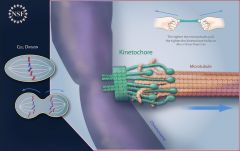
2. The kinetochore brutally separates the chromatid family |
|
|
Cyclins |
Proteins that activate kinases and can control entering the stages of cell cycle |
1. Mitiotic Cyclins 2. There are two major types of cyclins |
|
|
Kinases |
Proteins that carry phosphate groups to ATP and activate enzymes |

2. Kinases are used in exercise and cell division |
|
|
Cell-Cycle Arrest |
When cells are restricted from moving on in the cell cycle due to damage or mistakes |
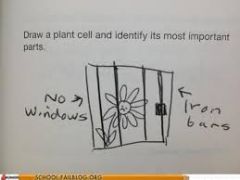
2. Cell-Cycle Arrest deactivates kinases |
|
|
Cancer |
A disease from damaged supressors and protooncogenes that results in uncontrolled cell division |
1. Brain Cancer 2. The uncontrolled cell division in cancer creates tumors |
|
|
Interphase |
The stages of the cell cycle between mitosis |
1. The G1 stage 2. Chromosomes are not visible during interphase |

